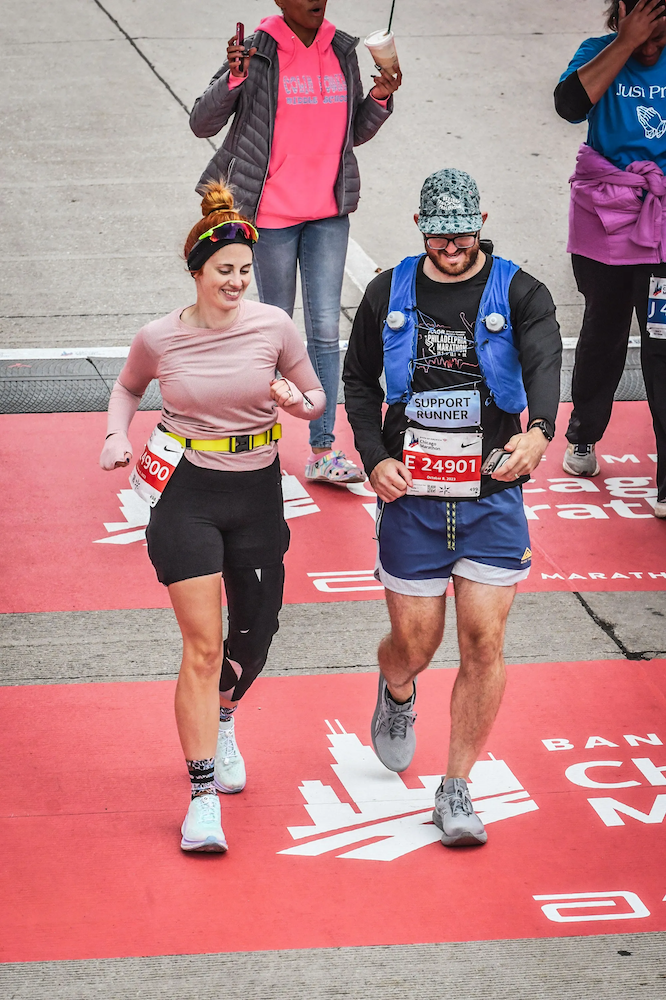
I’m Meghan. I was diagnosed with MS on June 30, 2020. On October 8th, 2023 I crossed the finish line of the Bank of America Chicago Marathon. Here is my story.
Growing up active
I grew up competitively dancing and doing most rec sports available to me. In college, I started running. Before receiving my diagnosis, I had run multiple half marathons and completed three full marathons.
A fall at the finish line
A year before receiving my diagnosis, I was running pretty consistently. That same year, I tumbled at the finish line of a half marathon. I was already experiencing symptoms of MS but didn’t know what foot drop was and that that was what had caused my fall. Still, the build-up for that half was the most consistent I had ever been with my training, so I did my best to maintain that for the next few months.
Entering the lottery for the Bank of America Chicago Marathon
On November 11, 2019, I decided to apply for the 2020 Bank of America Chicago Marathon. The Chicago Marathon is “flat and fast,” so I figured I would try the lottery for 2020 and run my fourth marathon much faster than my previous attempts.
A few weeks later, I got the email that I was accepted. I got ready to put everything I had into speed work before my official training program started. In April of 2020, everything changed.
On top of the pandemic, my ability to run was quickly disappearing, and the ability to walk wasn’t far behind but I still didn’t have an answer as to why. I had already gone to multiple doctors after falling at the finish line of the half marathon but still didn’t have an official diagnosis.
Receiving my official MS diagnosis
After what felt like a never-ending loop of unanswered questions and difficulty finding providers who were accepting new patients during a pandemic, I finally received my MS diagnosis in June of 2020. More than anything, I felt relief. I was relieved to finally have an answer. Two weeks later, the official email went out announcing the cancellation of the 2020 Chicago Marathon.
Along with it came options to refund your entry cost or defer your entry to 2021, 2022, or 2023.
I vividly remember getting the email. I was in our driveway going to the mailbox and I immediately started crying. I had THREE years to get back into marathon shape. I had just started treatment 4 days earlier. I wasn’t quite ready to run but was so excited that I was still going to have a chance at this race.
Instead of thinking, “What if I can’t…?” I thought, “What if I can?”
Over the next three years, I learned about foot drop, ataxia, and how I was impacted by heat. I also started experiencing vision issues. There were times when my job was stressful. As I ran more, my left foot drop became more pronounced.
As time went on, I knew I wouldn’t be able to run the entire race. The past three years taught me to be kind to myself. Instead of thinking, “What if I can’t?” she thought, “What if I can?”
Adapting training to accommodate the effects of MS
As I learned more about how MS was impacting me and my mobility, I made various accommodations to my training. I decided that running 1 mile, walking .25 miles, and repeating for as long as possible made the most sense for me. I woke up early in the summer to beat the heat. I listened to my body when I felt fatigued. I incorporated swimming and biking to cross-train. I took extra care with stretching. I found the balance between being kind to your body and mind and knowing when to push it and get out the door for something you really want.
Two attempts for my final 20-mile training run
It had been a few years since I’d run anything close to 20 miles. Throughout my training, every run over 14 miles was a celebration. It didn’t matter how good, bad, fast, slow, or hot those miles felt — it was a huge accomplishment.
For my final 20-mile training run, I had to make two attempts. The first time, I had to call my husband to pick me up after about 3 miles. It wasn’t going well.
The second time, I struggled the last few miles but got through them largely thanks to a mobility device I had just received, called the Cionic Neural Sleeve.
Improved endurance from the Cionic Neural Sleeve
I first heard about the Cionic Neural Sleeve on MS subreddit after researching options for foot drop. I knew other aids existed, but had never seriously looked into them. They were expensive and bulky. The sleeve is lightweight and looks more like a sports legging than a mobility device.
I didn’t have much time to train in the sleeve but was grateful I received it in time for race day.
Race day
The journey leading up to race day was a long one. It had been nearly four years since I’d fallen finishing a half marathon and three years since my official diagnosis. This day had been on my calendar since November of 2019 and now the start line was right in front of me. I got a bit emotional. It was not going to be the race I had hoped for in 2019, but I’m nowhere near the same person I was then.
My goal was to run as far as I could before putting on my Neural Sleeve. I ended up using it around mile 11.5, which was earlier than I wanted to, but I was tired. There was a lot of extra mental work involved compared to my training runs. I was surrounded by people, I had to avoid potholes in the road, and I had to be careful not to slip on water cups at aid stations.
Once I put it on, I realized I had “survived” the first 10 miles. After putting it on, I ran almost a half mile without fatigue. It was like I had just started the race. That was the last time I really “ran” for the rest of the marathon, but it was my favorite segment (including the start and finish) because I didn’t have to think. It took the mental load off. You don’t realize how much you’re thinking about how to walk or run until you don’t have to anymore.
Towards the end, my hip flexors were screaming at me. My left leg is actually more impacted by MS, but interestingly enough, with the sleeve on my left leg, my right leg was actually more fatigued. As I got closer to the finish line, I don’t think I had the mental capacity to fully process what I was accomplishing in the moment. I knew if I did, I would cry. And I am not opposed to crying — I just know that when I am tired all I can do is move forward. If I laugh or cry, I’ll stop moving. As I crossed the finish line, I was just happy it was over. 26.2 miles is no joke and only about 0.01% of the population has done it.

What’s next
I’ll be focusing on shorter distances and increasing my speed and strength. I have 5Ks coming up and am excited to get back into cross-training and lifting. Maybe someday I’ll try a triathlon (I love swimming, biking, and running, so why not?) I will continue to do what I can, when I can, with what I have. There will be tears on the harder days. I’ll continue to fall on runs for no reason other than my leg deciding it’s done working, but I know that a good cry, yell, and punch on the legs will be enough to walk angrily home. At times like those, I’ll remember I GET to run. I GET to do hard things. So I’m going to keep doing them until I can’t.
Final advice for others living with MS who are considering completing a marathon
First, obviously, make sure you are physically ready to tackle the beast that is a marathon. There are plenty of free online plans for marathons, so pick one that you can confidently complete the first few weeks of.
Equally important to being physically ready, is being mentally and emotionally ready. Consider the time of year the race is, what time of year that means training in, and what that looks like for your life and your challenges.
Most courses will have an elevation map somewhere online. Check that out too.
If you have a local run club, go! The running community is so welcoming and it doesn’t matter your pace. Having them as a support to lean on can be invaluable. If you don’t have a run club (I don’t), follow people on social media. Don’t compare yourselves to them. But you can get ideas for workouts, or even make online friends.
Last but not least, if you have a race in mind check out what accommodations they might have for athletes with disabilities or para-athletes. This might require a bit of research to see what you classify for and will likely require a doctor’s sign-off, but I would not have been able to get through the race without being a para-athlete and having my husband as my support runner. And if they don’t have anything, I would double-check by sending them an email.
Article written by Meghan Sliva
This is a user story from a Cionic customer who has not been compensated to share their story. This story does not represent the average customer experience. The Neural Sleeve is designed to improve gait and strength for individuals with upper motor neuron diagnoses. Individual results and experiences may vary. Consult with your doctor on treatment decisions.





